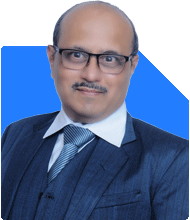Ramalingam Kalirajan |9755 Answers |Ask -Follow
Mutual Funds, Financial Planning Expert - Answered on Jul 05, 2024
He has an MBA in finance from the University of Madras and is a certified financial planner.
He is the director and chief financial planner at Holistic Investment, a Chennai-based firm that offers financial planning and wealth management advice.... more

This is a 37 year old married man with 2 young kids and a housewife with a private job with 73K in hand salary living in a rented flat in Chennai. I have cipla share of about 60 lacs values (inheritance) and other stocks and MF comprising total about 65 lacs of values (including cipla values) with around 7 lacs cash in bank. Just opened a demat account for my wife a couple of months back where I keep buying shares of about 2-3K each month. My share and MF investment each month is about 5-6K in my demat account (Sometimes more but that’s the average). After all these expenses and other personal expenses my savings is about 8-10K per month (Sometimes less and sometime more). I want to give good education (not necessarily very costly) to my kids in future as I am also educated. I don’t have any property except my ancestral home which I won’t be selling as it has many other claimants. Please suggest some investment plan so that I may be able to increase my corpus or maximize its use to full potential. Thanks....
Appreciating Your Efforts
First, let me appreciate your disciplined approach to savings and investments. It’s commendable that you are thinking about your family’s future and are already investing regularly. Now, let’s explore how you can enhance your investment strategy to achieve your financial goals.
Creating a Comprehensive Financial Plan
A well-structured financial plan is essential for achieving your financial goals. Let’s break down the key components of a comprehensive financial plan for your situation:
Building an Emergency Fund
An emergency fund is crucial for unexpected expenses. Aim to save at least six months' worth of expenses. This fund should be kept in a liquid and safe investment, such as a savings account or a short-term fixed deposit. This will provide financial stability in case of emergencies.
Reviewing Your Current Investments
You have a significant investment in Cipla shares, inherited from your family. While it’s good to have such a substantial asset, it’s essential to diversify your investments to manage risk effectively. Diversification helps in spreading risk and optimizing returns.
Reducing Direct Stock Investments
Direct stock investments can be volatile and require constant monitoring. Given your busy schedule and financial goals, it might be beneficial to reduce direct stock investments. Instead, focus more on mutual funds which are professionally managed and offer diversification. This strategy reduces risk and enhances potential returns.
Stocks and Mutual Funds
Your investment portfolio includes stocks and mutual funds worth Rs. 65 lakhs. Regular investments in stocks and mutual funds are a good strategy, but it’s crucial to review and rebalance your portfolio periodically. This ensures that your investments align with your financial goals and risk tolerance.
Investing in Your Wife’s Demat Account
You have started investing Rs. 2-3K each month in your wife’s demat account. This is a smart move, as it helps in building a separate investment portfolio for her. However, consider directing these investments towards mutual funds instead of direct stocks. This will provide professional management and diversification, ensuring better risk management.
Systematic Investment Plan (SIP)
SIPs are an excellent way to invest in mutual funds. They allow you to invest a fixed amount regularly, which inculcates disciplined investing. SIPs help in averaging out the cost of investments and reduce the impact of market volatility. Even a small monthly investment can grow significantly over time due to the power of compounding.
Power of Compounding
Compounding is a powerful concept in investing. It allows your investment earnings to generate additional earnings over time. The earlier you start investing, the more you can benefit from compounding. For instance, a small investment made now can grow substantially over the years, providing a significant corpus for your children’s education or other financial goals.
Exploring Mutual Funds
Mutual funds offer diversification, professional management, and potential for high returns. They are a suitable investment option for long-term goals. Let’s explore the different categories of mutual funds:
Equity Mutual Funds
Equity mutual funds invest primarily in stocks. They offer high growth potential but come with higher risk. Given your age and financial goals, equity mutual funds can help you build wealth over the long term. Start with a small amount and gradually increase your investment as you become more comfortable.
Debt Mutual Funds
Debt mutual funds invest in fixed income securities like bonds and government securities. They are less risky compared to equity funds and provide stable returns. Debt funds can be a good option for balancing your portfolio and reducing overall risk.
Hybrid Mutual Funds
Hybrid mutual funds invest in both equities and debt instruments. They offer a balanced approach, providing moderate returns with reduced risk. These funds are suitable for investors who are looking for a mix of growth and stability.
Tax Planning
Tax planning is an integral part of financial planning. Certain mutual funds offer tax benefits under Section 80C of the Income Tax Act. Equity Linked Savings Schemes (ELSS) are a popular option. They provide tax deductions and have the potential for high returns. Consider allocating a portion of your investments to ELSS to optimize your tax savings.
Setting Financial Goals
It’s important to set clear financial goals. Determine what you want to achieve with your investments, whether it’s providing for your children’s education, buying a house, or saving for retirement. Having specific goals will help you stay focused and motivated.
Education Planning for Your Kids
Providing good education for your kids is a priority. Estimate the future costs of education and create a dedicated investment plan for this goal. Consider investing in mutual funds with a long-term horizon to build a substantial corpus for their education.
Retirement Planning
Even though retirement might seem far away, it’s essential to start planning early. Estimate your retirement expenses and create a dedicated investment plan to build a retirement corpus. Regular investments in mutual funds and other long-term instruments can help you achieve financial security in retirement.
Avoiding Common Pitfalls
Avoid Direct Funds
Direct funds require you to manage your investments yourself, which can be time-consuming and complex. Regular funds, managed by a Certified Financial Planner (CFP), provide professional guidance and can help you make informed decisions.
Disadvantages of Index Funds
Index funds track a specific index and offer lower returns compared to actively managed funds. They don’t have the flexibility to adapt to market changes. Actively managed funds, guided by experts, aim to outperform the market and provide better returns.
High-Risk Investments
Avoid high-risk investments like speculative stocks or cryptocurrencies. They can offer high returns but come with significant risk. It’s important to prioritize stability and long-term growth over quick gains.
Health and Life Insurance
Having health insurance is crucial to protect your family against medical emergencies. Medical expenses can be high and can drain your savings. Health insurance provides financial coverage and peace of mind.
Life Insurance
Life insurance is essential, especially since you have dependents. It ensures financial security for your loved ones in case of an unfortunate event. Term insurance is a cost-effective option. It provides high coverage at a low premium.
Regular Review and Rebalancing
Regularly review your investment portfolio to ensure it aligns with your financial goals. Market conditions change, and so do your personal circumstances. Rebalancing involves adjusting your portfolio to maintain your desired asset allocation. This practice helps in managing risk and optimizing returns.
Seeking Professional Advice
Consulting a Certified Financial Planner (CFP) can be beneficial. A CFP provides personalized advice based on your financial situation and goals. They can help you create a comprehensive financial plan and guide you in making informed investment decisions.
Final Insights
Starting your investment journey at a young age is commendable. It sets the foundation for a secure financial future. Focus on building an emergency fund, diversifying your investments, and setting clear financial goals. Regularly review and rebalance your portfolio. Prioritize stability and long-term growth. Seek professional advice when needed.
Your financial journey is unique, and with the right strategies, you can achieve your goals. Keep learning, stay disciplined, and be patient. Your efforts will pay off in the long run.
Best Regards,
K. Ramalingam, MBA, CFP,
Chief Financial Planner,
www.holisticinvestment.in
You may like to see similar questions and answers below
Ramalingam Kalirajan |9755 Answers |Ask -Follow
Mutual Funds, Financial Planning Expert - Answered on May 29, 2024
Ramalingam Kalirajan |9755 Answers |Ask -Follow
Mutual Funds, Financial Planning Expert - Answered on May 29, 2025
Nitin Narkhede |93 Answers |Ask -Follow
MF, PF Expert - Answered on May 25, 2025
Dr Nagarajan J S K |1803 Answers |Ask -Follow
NEET, Medical, Pharmacy Careers - Answered on Jul 16, 2025
Dr Nagarajan J S K |1803 Answers |Ask -Follow
NEET, Medical, Pharmacy Careers - Answered on Jul 16, 2025
Nayagam P P |8906 Answers |Ask -Follow
Career Counsellor - Answered on Jul 16, 2025
Nayagam P P |8906 Answers |Ask -Follow
Career Counsellor - Answered on Jul 16, 2025
Nayagam P P |8906 Answers |Ask -Follow
Career Counsellor - Answered on Jul 16, 2025
Ramalingam Kalirajan |9755 Answers |Ask -Follow
Mutual Funds, Financial Planning Expert - Answered on Jul 16, 2025
Ramalingam Kalirajan |9755 Answers |Ask -Follow
Mutual Funds, Financial Planning Expert - Answered on Jul 16, 2025
Radheshyam Zanwar |5441 Answers |Ask -Follow
MHT-CET, IIT-JEE, NEET-UG Expert - Answered on Jul 16, 2025
Radheshyam Zanwar |5441 Answers |Ask -Follow
MHT-CET, IIT-JEE, NEET-UG Expert - Answered on Jul 16, 2025
Radheshyam Zanwar |5441 Answers |Ask -Follow
MHT-CET, IIT-JEE, NEET-UG Expert - Answered on Jul 16, 2025









.jpg)











